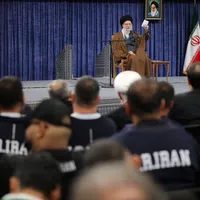The 12-day conflict ended without a written agreement, leaving Iran trapped between war and peace.
Instead of rebuilding through reform or reconciliation, the Islamic Republic has doubled down on surveillance, militarization and the distribution of privilege among loyalists.
What has emerged is a system of permanent crisis management: endurance without renewal.
The real decision-makers in Tehran show no appetite for dialogue with the West, and are unwilling to acknowledge recent political and military setbacks or contemplate change.
The priority has become the securitization of every sphere of life—with key decisions even more concentrated in security bodies, and politics almost wholly transferred to backrooms.
A web of military institutions, economic foundations and domestic platforms mediates between state resources and loyal factions. Executions and heavy sentences have surged; and digital rationing and surveillance have expanded.
More ominously, perhaps, official rhetoric is now focused on the threat of foreign enemies and the need for “constant readiness.” Public life is framed as part of a “media war,” while selective enforcement of hijab laws seeks to contain public anger.
Securitized economy
The boundary between political and security institutions has effectively vanished, with routine governance filtered through bodies such as the Supreme National Security Council.
This securitization coincides with an economic shift.
The government’s developmental role has withered, replaced by a mechanism that distributes limited resources among the faithful.
Economic access—to loans, licenses, or capital—now depends more than ever on political trust, reinforcing the role of intermediaries and fueling the rise of new oligarchs.
Together, these dynamics have produced a control-centered order where security agencies, economic foundations, and data platforms operate as a single network.
Decisions are shaped by military priorities and calibrated to maintain balance among loyal factions. Society is governed through access management, creating obedience through the fear of exclusion.
Longevity but no renewal
This post-war order relies on the state’s ability to maintain control and contain crises.
For now, it has prevented wider instability, but its tools are inherently exhaustible. Surveillance must constantly expand to preserve the same level of discipline; redistribution, when not backed by production, steadily drains what remains of the economy.
Decision-making has become reactive and short-term, aimed at averting immediate risks rather than shaping a long-term vision. Institutions function but no longer evolve; ad-hoc councils have replaced political processes
The result is a façade of coordination that in reality narrows the space for reform.
The endurance of this system stems less from institutional strength than from fear—of both domestic unrest and external pressure—and from the absence of political alternatives.
Dissenting forces lack organization; insiders lack capacity for change. The Islamic Republic thus persists through a passive form of survival, feeding on control and limited access to resources.
It may last for years, but this durability is merely a postponement of decisions, one whose eventual cost will fall on both the state and the Iranian people.











